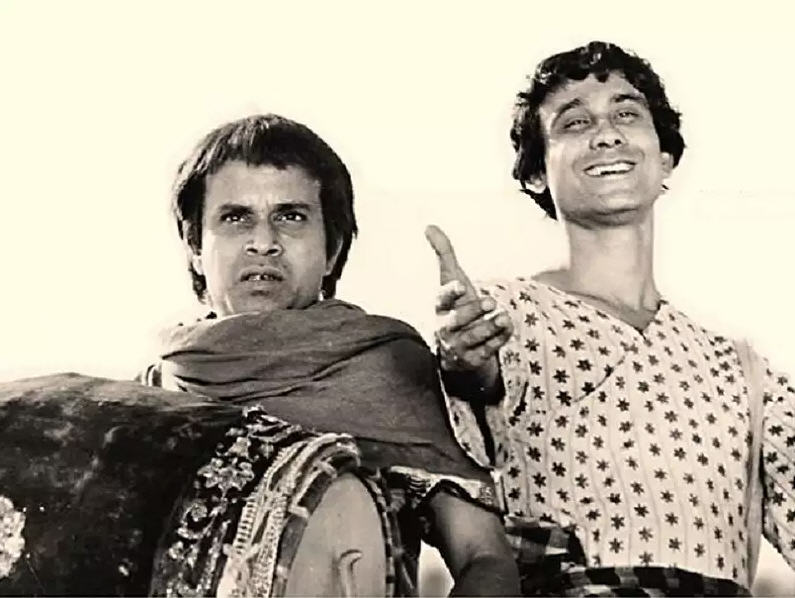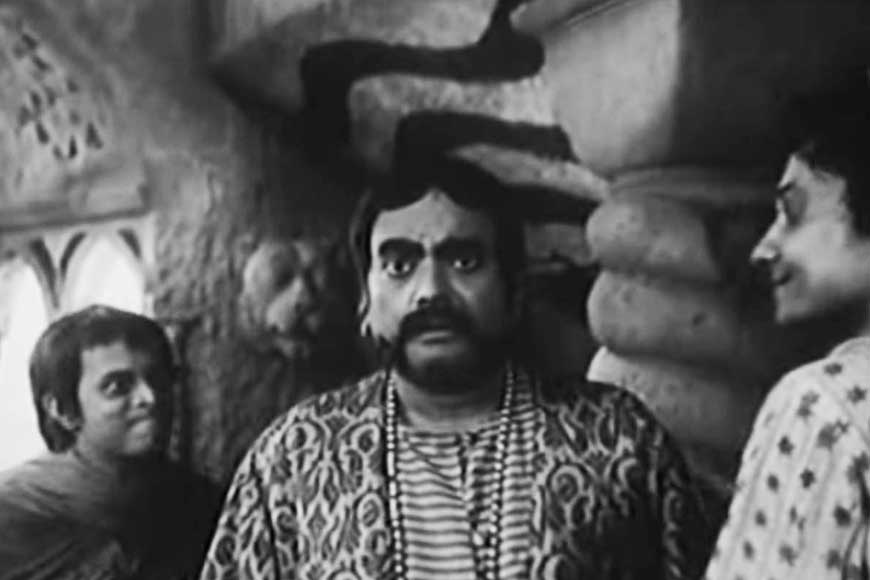 & Telegram
& Telegram  Channel
Channel  & Telegram
& Telegram  Channel
Channel 
Anshula’s most favourite pastime is watching old movies and songs. Satyajit Ray’s iconic musical Goopy Gyne Bagha Byne was thus an instant choice when asked to contribute to Ray@100 series. 😊

Tapen Chatterjee as Goopy Gyne (R) and Rabi Ghosh as Bagha Byne
Goopy Gyne Bagha Byne is a film directed by Satyajit Ray. Starring Tapen Chatterjee (as Goopy) and Rabi Ghosh (as Bagha), it’s a story about two musicians – Goopy, a singer and Bagha, a drummer who are thrown out of their villages Amloki and Hortuki, respectively by their kings.
In the film, the things I liked the most were first, the songs which had very funny lyrics. The film is full of suspense and every dialogue and scene is unforgettable.
Let us get a small glimpse of the film. As I already said, Goopy and Bagha the two musicians are banished to the forest because of singing or playing the dhol just for their own pleasure. But then there is a twist in their destiny.
The King of Ghosts (‘Bhooter Raja’ in Bengali) gives them three boons. First, whatever food they would like to eat or any clothes they would like to wear would come to them instantly if they clap each other’s hand (or what we now call a High Five).

Goopy and Bagha can eat their favourite food wherever and whenever
Second, whenever or wherever they start singing, no listener will be able to move.
Third, by wearing the magic pair of shoes given to them by the King of Ghosts whichever place they would wish aloud, they could go instantly after clapping their hands of course. Just think, if these types of boons or dreams come true, then what will remain in life to worry about? Everything would be in our own hands.
Now let’s talk about the kings of Shundi and Halla, the twins. Both of them (played by Santosh Dutta in a double role) are very kind and decent but the King of Halla has been brainwashed by his evil minister and a magician. That’s the reason, Halla wants war and Shundi wants peace. Goopy and Bagha both go to the King of Shundi where they sing the song Maharaja tomare selam (Salutations, your highness) at the music competition. Listening to their song everyone including the king becomes a statue. Only when Goopy claps thrice to break the spell, everyone starts dancing with joy and happiness.
The scene I liked the most is the one where the King of Shundi falls asleep while listening to all the classical songs of the participating musicians. His crown, which looks more like an oversized cushion topples from his head when Goopy’s song ends and the king starts jumping up and down, almost like a bhangra.
Maharaja, tomare selam
When the King of Halla sends a letter to the King of Shundi declaring war or asking him to surrender, the King of Shundi feels tensed up about his brother. Then, Goopy and Bagha come forward to help the king by going to Halla as his spies. At that time, the King of Shundi says he will give his daughter Monimala in marriage to one of them. Then Bagha starts dreaming about the princess as his wife. Just when they are starting their journey to Halla, both of them see her standing at her balcony.

Jahar Roy as the evil minister
When the evil minister of Halla tries to arrest them, Goopy and Bagha fool the minister and the magician and escape by singing, which freezes them into statues. The best song in the film for me is Ore Goopy re, chol bhege podi chupi chupi re (Goopy, let’s quietly sneak out and run from here) and the funniest and best line in the song is Mundu gele khabo ta ki? Mundu chhada banchbo na ki? (How will I eat without my head? I won’t be able to live without my head). Bagha is more worried about how he will eat without his head, forgetting that he wouldn’t even live if the head is knocked off! But to Bagha, eating is top priority!
And then the unforgettable song O montri moshai shorojontri moshai thhemey thak (Oh Mr Minister, Mr Conspirator, stop where you are) where both of them, using their magical power of singing, escape right under the nose of the evil minster and take away the medicine made by the magician for making dumb people speak.
O re Halla Rajar sena
But the one thing I disliked most was the starvation of people in Halla. When Goopy and Bagha clap to order sweets for all the soldiers, the starving soldiers forget all about the minister and run for the sweets. The evil minister cannot provide food to the people of the kingdom because he is too busy trying to grab as much power as he can by giving the king a medicine that makes him very cruel and follow the minister’s commands blindly.
All soldiers run for the sweets like mad, and the minister frantically tries to stop them. When somehow the ‘Montri moshai’ catches hold of a pot of sweets, his luck runs out and someone puts his foot on the pot and the pot breaks.
Bhooter Nach – The Dance of the Ghosts
The ghost dance presents the history of India as the cruel zamindars, merciless Britishers, exploitative Brahmins and priests and the needy poor peasants come in one by one, dancing to very interesting instrumental music. Gradually, all of them start dancing in their own rows arranged class wise. This shows the discrimination between the people on the basis caste, class and creed. The song which our Bhooter Raja sings sounds like a nasal rap more than a song to me. My mother says that Satyajit Ray had sung the song first very slowly and then made it fast forward several times and used it as a rap. This one is also one of my favourite songs of the film.
While it is a fantasy film for children, it is a film for all people as it has fun, comedy, beautiful lyrics, historical effects, unique costumes (especially the magician’s two bouncing yo yos on his cap) and great music.
Whether you are new or veteran, you are important. Please contribute with your articles on cinema, we are looking forward for an association. Send your writings to amitava@silhouette-magazine.com
We are editorially independent, not funded, supported or influenced by investors or agencies. We try to keep our content easily readable in an undisturbed interface, not swamped by advertisements and pop-ups. Our mission is to provide a platform you can call your own creative outlet and everyone from renowned authors and critics to budding bloggers, artists, teen writers and kids love to build their own space here and share with the world.
When readers like you contribute, big or small, it goes directly into funding our initiative. Your support helps us to keep striving towards making our content better. And yes, we need to build on this year after year. Support LnC-Silhouette with a little amount – and it only takes a minute. Thank you
Silhouette Magazine publishes articles, reviews, critiques and interviews and other cinema-related works, artworks, photographs and other publishable material contributed by writers and critics as a friendly gesture. The opinions shared by the writers and critics are their personal opinion and does not reflect the opinion of Silhouette Magazine. Images on Silhouette Magazine are posted for the sole purpose of academic interest and to illuminate the text. The images and screen shots are the copyright of their original owners. Silhouette Magazine strives to provide attribution wherever possible. Images used in the posts have been procured from the contributors themselves, public forums, social networking sites, publicity releases, YouTube, Pixabay and Creative Commons. Please inform us if any of the images used here are copyrighted, we will pull those images down.
Racy and good narrative. Liked it .
A connoisseur’s ear for music. Well put across
Continue writing
Thank you Bimal uncle. I liked your comment a lot. This one is one of my favourite favourite movies of Satyajit Ray, not only because it has a lot of comedy and fun. But also because of the bravery and helpfulness of both Goopy and Bagha.
Excellently written Miti. You reminded me of the mid seventies when I saw this movie at Mahadev rd auditorium behind AIR building New Delhi. Beautifully described the songs and the reactions of the Bhooter king’s reaction. I would like to see the movie once again so I can enjoy it thoroughly once again. Keep writing Miti ..
Incredible grasp of the plot and characters. To understand Ray’s movies even adults need to fine-tune their sensors 14 year old Anshula deserves round of applause for an excellent review of the film.
Thank you so much Kunal uncle. I loved your comment. Writing reviews and watching Ray’s films and songs are my passion.
Miti shonar lekha pore abar kore cinema ta dekha hoe gelo.
Aito shundor narration, puro chobir moto chokher shamne elo.
Boro guner meye hoyeche 😘😘
Onek onek dhonyobad Mitali didu. Tomar comment ta pore khub bhalo laglo. Tomar chhobi ta kamon laglo?
Excellent👌& Outstanding👏👏… Our blessings and best wishes are always with Anshula!! Keep it up👍
Thank you uncle loved your comment a lot. It was a great experience writing on Satyajit Ray’s film. This is one of the my favorite films of Satyajit Ray.
Thank you uncle for your comment . It was a great experience writing on Satyajit Ray’s film. This is one of the my favorite films of Satyajit Ray.
Excellent! She is a torch bearer maintaining the heritage and tradition. I’m very much impressed by her clarity of thoughts, analytical ability and expression at her age. A bright new future prospect. I wish her all the best and all success in her future endeavour. God bless her.
I venture to suggest her to move from Upendra Kishore to Tagore and Ray to Sinha without hindering her freedom of choice and expression.